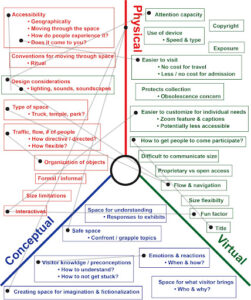By Alyssa Pier
“Curators are more like landlords than professors.” – Emily Wilkes, IUPUI Museum Studies Graduate Student
I know what you are thinking: curators do not necessarily teach, nor do they necessarily have real estate. What kind of nonsense is this? The quote is just one of the many ideas and revelations that this week’s class discussion on space sparked. In essence, my colleague’s point was that we must think about the way curators make space available for others to activate; creating an exhibition is not always about conveying information.
At the beginning of class, Mary Jane Jacob’s chapter “Making Space for Art” heavily influenced our discussion. This article challenged us to grapple with the concept of space in relation to exhibits and curatorial work. At surface level, space may appear to be just physical like the distance between objects or the dimensions of the exhibition space. What goes into this space? If the answer is only artwork, artifacts, objects, or lack thereof, that answer is not complete.
As curators, our role extends far beyond placing objects in a room; we must utilize the space and open it for the viewer. We are not supposed to dominate the experience, make the viewer’s choice for them, or assume we know it all. Curators are tasked with creating a space that values and acknowledges the viewer to foster their own interpretation, growth, and/or experience via the exhibition.
But how do we do that? We must begin to think about space beyond its physicalness. The space could be virtual, or it could be a moving experience. Perhaps, the space created is mentally centered for reflection and growth, or a conceptual space that introduces individual meaning making.
Both multidimensional and complex in nature, the concept of space is way too detailed for our class to tease out in a single class discussion. Our discussion was not exhaustive, but we made great strides in understanding the concept of space, its relation to curatorial work, and its larger connection to our collaborative partnership with the Museum of Broken Relationships. The graphic below illustrates the three components of space that we chose to identify and elaborate: physical, virtual, and conceptual space.

This image is a space diagram that we created in class. Three types of space are outlined in coded colors. Physical Space is red. Virtual Space is green, and Conceptual Space is blue. Each of the three space types have a series of components that are coded in their respective colors. Several components are linked to each other via a black line segment to represent their similarities and connectedness.
Each color-coded section has a series of facets that we deemed important to consider. These facets are then connected throughout the diagram to other areas that we deemed to be related and/or similar. This diagram is nowhere near complete or all-encompassing; however, the complexity is reflective of the intricate concept of space.
Our collaborative diagram is important as it serves as a point of reference for exhibit making, especially for our collaboration with the Museum of Broken Relationships. Working in teams, students from our class will be creating satellite displays that extend The Museum of Broken Relationships Indianapolis exhibit to sites around Indianapolis. Each satellite display will only have one to three objects and the physical space they will reside in will be relatively small. Thus, we must be creative and craft space thoughtfully considering not just physical features, but also conceptual and/or virtual components. Reflecting on our discussion and class material, some ideas to keep in mind when working on our satellite exhibits include:
- Who is the exhibit for, and why? It is important to realize that the exhibition is not for us, the viewer and audience should be the center of our focus.
- What major topics do we need to consider? Exhibition design in general should be thoughtfully crafted, but accessibility and overall attention capacity should be of concern as well.
When creating an exhibit, it can be easy to be swept up in the process. Unfortunately, this leaves room for assumptions, errors, and the exclusion of potentially important factors. Of course, we cannot meet all of these expectations or include every consideration that we identified in class, but it is helpful to have all of this information in one place for reference. It is our hope that this is beneficial to other curators as well, as we are all lifelong learners.
Alyssa Pier is a second year MA student in the IUPUI Museum Studies Program.
Work Cited:
Jacob, Mary Jane. “Making Space for Art.” In What Makes A Great Exhibition? edited by Paula Marincola, 134-141. Chicago: University Chicago Press, 2006.

